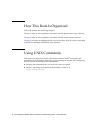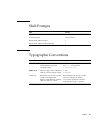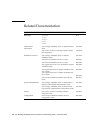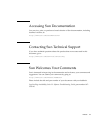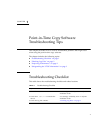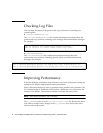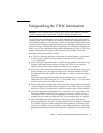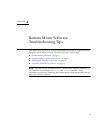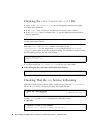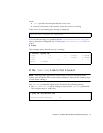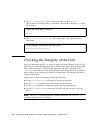
Chapter 1 Point-in-Time Copy Software Troubleshooting Tips 3
Safeguarding the VTOC Information
Caution – When creating shadow volume sets, do not create shadow or bitmap
volumes using partitions that include cylinder 0. Data loss might occur.
The Solaris system administrator must be knowledgable about the virtual table of
contents (VTOC) that is created on raw devices by the Solaris operating system. The
creation and updating of a physical disk’s VTOC is a standard function of the Solaris
operating system. Software applications like the Sun StorEdge Availability Suite, the
growth of storage virtualization, and the appearance of SAN-based controllers have
made it easy for an uninformed Solaris system administrator to allow a VTOC to be
altered inadvertently. Altering the VTOC increases the possibility of data loss.
Remember these points about the VTOC:
■ A VTOC is a software-generated virtual table of contents based on the geometry
of a device and written to the first cylinder of that device by the Solaris
format(1M) utility.
■ Various software components such as dd(1M), backup utilities, point-in-time copy
software, and remote mirror software can copy the VTOC of one volume to
another volume if that volume includes cylinder 0 in its mapping.
■ If the VTOC of the source and destination volumes are not identical, some type of
data loss might occur. This data loss might not be detected initially, but can be
detected later when other utilities are used, like fsck(1M), or when the system is
rebooted.
When first configuring and validating volume replication, save copies of all
affected devices’ VTOCs using the prtvtoc(1M) utility. The fmthard(1M) utility
can be used to restore them later, if necessary.
■ When using volume managers like SVM and VxVM, copying between individual
volumes created under these volume managers is safe. VTOC issues are avoided
because the VTOC is excluded from volumes created by these volume managers.
■ When formatting individual partitions on a raw device, for all partitions except
the backup partition, make sure the partitions do not map cylinder 0, which
contains the VTOC. When using raw partitions as volumes, you are the volume
manager and you need to exclude the VTOC from partitions that you configure.
■ When formatting the backup partition of a raw device, make sure that the
physical geometries of the source and destination devices are identical. (Partition
2, by default, maps all cylinders under the backup partition.) If identical device
sizing is not possible, make sure that the source backup partition is smaller than
the destination partition and that the destination partition does not map cylinder
0.




